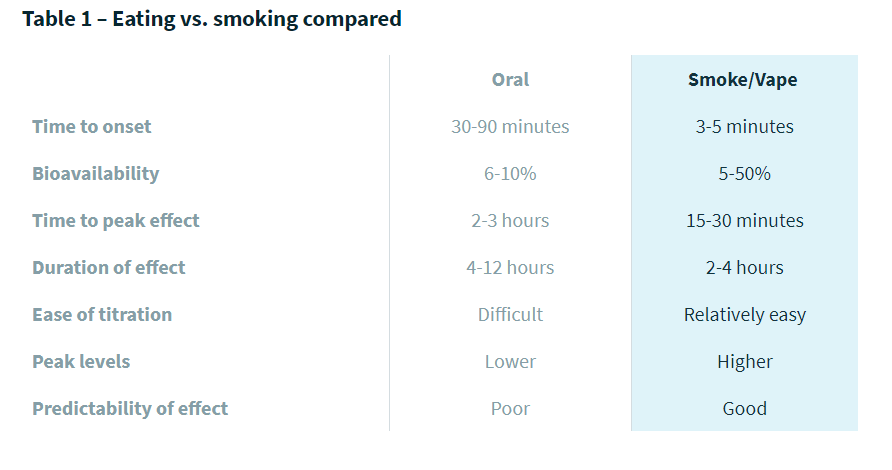May 2021 Update on Cannabis Edible Products
What are cannabis edible products?
Cannabis can be taken in different forms by smoking, eating or drinking, such as in herbal tea. Cannabis ‘edibles’ are food products infused with cannabis. Edibles come in many forms—including baked goods, sweets, ’gummy bears’, 'jellies', ‘star bars’, chocolates and lozenges. They have many different names that include 'space cakes', ‘edibles’, 'gummies', 'THC sweets’, ‘medibles’. On review of these products online, the most common terms on the Irish market appear to be ‘edibles’ and ‘gummies’. We have also observed THC drinks such as ‘THC Lean’ available.
Food products containing cannabis have been available internationally in locations such as the Netherlands as cakes sold in coffee shops or in situations where a cannabis consumer independently prepares cannabis for cooking. More recently, food products containing cannabis extract have emerged as part of the legalised market in Northern America and are not legalised in an Irish context. Many of these products replicate commercial food brands, however some do not and a number of independent suppliers are selling baked goods and home infused drinks.
While cannabis edible products are not a new drug trend, a novel market has emerged but the longevity of this trend will need to be monitored. The changing market is mainly linked with vibrant branded products and new media.
Who uses these products?
The novel products may create interest from a number of using populations and young people; however, there is very limited information in relation to the use of these substances and the rationale for use in an Irish context.
While drug seizure data from law enforcement shows an increase in edible product detections, this does not identify the intended user groups. At present, we expect use mostly among young adults over the of 18. The price of the products may be a protective factor to prevent very young populations purchasing.
The Irish situation
We are aware of a small number of hospitalisations as a result of cannabis edible consumption. Presentations consisted of adverse mental health reactions such as hallucinations as well as seizures as a result of use. Products seized in Ireland have not been subjected to quantitative analysis, meaning we are unsure of the amount of THC contained in products and if the packaging correctly shows the dose/strength.
Effects may be different
The effects a person experiences will be based on their existing mind-set, exiting mental health concerns, the setting they are in, their gender, weight, metabolism, if they have eaten, the potency of the product, how much is consumed and if the product contains unknown compounds. This will be different for each person.
The overall experience from ingestion may differ to the inhalation of cannabis. This is as a result of how the body responds to this form of consumption. While smoking cannabis avoids what is known as ‘first pass metabolism’ (being broke down by the liver), ingestion enables the liver to breakdown cannabis into over 50
metabolites, some of which are psychoactive. When eaten, almost 100% of THC gets converted to the compound 11-hydroxy-THC compared to only 20% that converts after smoking. Overall, the compound 11- hydroxy-THC is more psychoactive than THC which leads to a more intense effects or people feeling ‘more stoned’.
metabolites, some of which are psychoactive. When eaten, almost 100% of THC gets converted to the compound 11-hydroxy-THC compared to only 20% that converts after smoking. Overall, the compound 11- hydroxy-THC is more psychoactive than THC which leads to a more intense effects or people feeling ‘more stoned’.
The most prominent difference between ingestion and inhalation of cannabis extracts is the delayed onset of drug effect. A person will not feel the effects immediately like smoking cannabis. In some cases it could take over two hours before the peak effects are felt. It is harder for a person to know an accurate dose or gauge
how they will react compared to inhaling. People may easily consume too much THC without knowing until the effects are felt some time later.
how they will react compared to inhaling. People may easily consume too much THC without knowing until the effects are felt some time later.

Image source: The Global Drug Survey
Although it takes longer for the initial effect to be felt, the resulting effects can last longer with a peak of around 2-4 hours (Grotenhermen, 2003). In some cases the
effects can be up to or longer than 9 hours +.
effects can be up to or longer than 9 hours +.
While taking edible products may not lead to fatalities, they can cause paranoia, anxiety, vomiting, nausea, prolonged delusions or hallucinations which can be frightening, mentally difficult or lead to accidental injury.
Laboratory analysis of edibles and ‘smokable’ cannabis available in Colorado suggests that 1 mg of THC contained in an edible produces a behavioural effect similar to 5.71 mg contained in smokable cannabis, however further studies on this area are required
The increased demand for this market may lead to counterfeit products emerging which are not regulated. The emergence of synthetic cannabinoids is also a concern which can lead to poisoning. This market is not being monitored in Ireland to identify the contents or measurement of THC in products. People should treat this area with the same caution as other substances while being mindful that product labels may not reflect the contents or potency of the product.
- About Cannabis Edible Products
- Global Drug Survey
- Harm reduction information for people who use cannabis edible products
- UK media Counterfeit Edibles Are Being Sold on Instagram – And Putting Kids in Hospital














